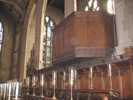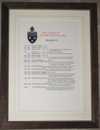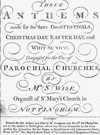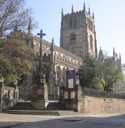For this church:    |
| |||||||||||||||||||||||||||||||||||||||||||||||||||
 Drawing from 1871 Drawing from 1871of the Bishop & Starr Organ by George Gilbert Scott |
Organ by Bishop & Starr
To install this organ part of the thickness of the north chancel wall had to be reduced (an effect that can still be seen today) and the entrance to the clergy vestry had to be moved several feet to the west. At the suggestion of Canon Morse the latest technology of hydraulic power for blowing the organ was installed. Water pressure was a problem and after much discussion a tank was placed in the tower. The engine and bellows were installed in the clergy vestry. The opening date for the organ was postponed because of lack of water pressure, and facilities for hand blowing installed. A comment in the 1871/2 annual report states that “additional expense of the new organ requiring two men instead of one to blow it”. The organ continued with further modifications until 1915, when it was replaced by a temporary organ by J W Walker & Sons, whilst the better parts from the Bishop and Starr organ were used in the new organ.
 The
Walker organ loft The
Walker organ loftprojecting over the south choir stalls |
Organ by J W Walker & Sons
In 1911 work began on a new chapel by Temple Moore on the side of the south chancel which was also to provide a position for the new organ. This was to include a boiler house beneath. Electricity was installed for lighting, heating and blowing the new organ. It was finally opened 25th May 1916. The heat from the boiler house beneath began to cause defects to the blowing system, so much so that heating to the organ was cut off.
The organ continued to have problems and after several refits failed completely during Easter 1968, to be replaced by a temporary organ by Grant, Degens and Bradbeer.
Temporary Grant, Degens and Bradbeer Organ
This small organ was placed in front of the screen near the south east pillar of the tower. There was the usual discussion as to where a new organ should be located and who should supply it.
 The
current organ The
current organ |
The current Marcussen & Søn Organ
The order for the new organ was placed in 1971 with Marcussen & Søn of Denmark, this was the company’s first installation in Britain and would be used as a ‘shop window’. After much deliberation a site above the Lady Chapel entrance was chosen and cantilevered out into the crossing. The organ was finally dedicated on 22nd September 1973. To this present day the organ is still in its original position and continues to give good service.
Specification of the Current Organ
HovedvaerkPrincipal 8 |
BrystvaerkGedakt 8 |
PedalSubbas 16 |
||
CouplersBrystvaerk/Hovedvaerk Brystvaerk with swell doors |
||||
The Organists
 The
list of The
list oforganists |
At the entrance to the newel stairs up to the organ, is a framed list of organists, the calligraphy by Katherine Harley. This was presented by the Friends of St Mary’s in February 1999.
| 1705?-1712 | Thomas Rathbone |
| 1712?-1755 | William Lamb |
| 1755-1802 | Samuel Wise |
| 1802-1818 | John Pearson |
| 1825-1831 | John Pearson (son?) |
| 1831-1836 | William Aspull |
| 1836-1874 | Charles C Noble |
| 1867-1904 | James Arthur Page (FRCO) |
| 1903-1914 | William Fredrick Dunnill (FRCO, ARCM) |
| 1914-1922 | Frank Radcliffe (MusDoc. FRCO) [Disruption over War Period] |
| 1914-1916 | J. E. Gomersall (FRCO) [Disruption over War Period] |
| 1914-1925 | Charles A. Howell [Disruption over War Period] |
| 1922-1928 | Vernon Sydney Read (ARCM, FRCO) |
| 1928-1954 | Henry Oswald Hodgson (FRCO) |
| 1954-1956 | David James Lumsden (MA, DPhil, BMus, Hon FRCO) |
| 1957-1967 | Russell Arthur Missin (ThD, FRCO, (CHM) ADCM, LTCL) |
| 1967-1983 | David Sheeran Butterworth (MA, MusB, FRCO, (CHM)) |
| 1984- | John Anthony Keys (MA, LRAM, ARCM, ARCO) |
The list of organists at St Mary’s begins with Thomas Rathbone (organist 1705-1712). Both he and the second organist, William Lamb (1712-1755), were employed by the Bluecoat School.
 Cover of the book Cover of the bookof Festival Anthems by Samuel Wise |
Samuel Wise, 1730-1802 published music for the celebrations held for the coronation of George III and for the festivals of Christmas Day, Easter Day and Whit-Sunday.
In the Diary of Abigail Gawthern it is recorded:
Nov 1st 1771 I began music with Mr. Wise, the organist at St Mary’s. Nov 18th 1802 Mr Wise the organist at St Mary’s died; he was appointed to the situation in the year 1756; he was buried in St Mary’s burying ground the 23rd; he was a music master, and taught a great many.
On the 8th June 2000 there was a rededication service at Wilford Hill for the remains of the people exhumed from St Mary’s bottom burial ground on Barker Gate, before the building of the new Ice Arena. One of the rededications was Samuel Wise organist and composer at St Mary’s from 1755 until his death in 1802. At the service parts of Samuel Wise’s Three Great Anthems were sung.
In 1916 The Arthur Page Scholarships were set up, in memory of James Arthur Page organist 1867-1904. The objects were in assisting the supplementary musical education of the choir boys of this church, from income derived from the invested funds. The eligibility was: “Any boy who has for two years been a chorister in this church, and is of good character and behaviour, may receive assistance.”
In the 1950s, under Henry O Hodgson (1928-1954) St Mary’s had the biggest church choir in the country.
In 2009 the Director of Music is John Anthony Keys. He has been at St Mary’s since 1984, having been formerly assistant organist of Chester Cathedral and Holy Trinity church Geneva, and Organist Titulaire, Eglise St Jean, Geneva. The organist is Andrew Abbott.
There is now a choral scholarship scheme for people in full time education, which attracts student singers from the Universities. There is also an organ scholarship scheme in partnership with Trent College, Long Eaton which attracts people who want some experience, usually before taking up an organ scholarship at Oxford or Cambridge.
Items from the History of the Choir
In March 1773 two men were sentenced to be hanged at the usual place of execution. The procession moved through the town and up the hill very slowly, occupying nearly an hour and a half in its progress. The singers of St Mary’s church sang penitential psalms the whole of the way.
In the Minute Book of 1884 it states that the old rule that the number of choir men shall not exceed 40 is re-affirmed and must be enforced.
Choir Vestry
In 1910 the choir vestry was in the north-west corner of the church, behind a wooden partition where some 70 boys and men robed for services, with the cassocks and surplices hung upon the wall. The wooden partition was removed in 1927, the ‘new’ vestry [Chapter House] being used for robing. Their predecessors of fifty years before consisted of half a dozen male and female voices, augmented by the children of the charity school. The present choir vestry at the north-west of the church was by Earnest A Heazell & Son and completed in 1940. It has a cross beam ceiling with three bosses. On the east wall is a wooden plaque inscribed:
This building was provided by a Benefaction of John Alexander Simpson for many years a worshipper at this church and was erected to his memory A.D. 1940.






